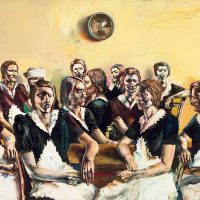It would have been impossible to display such a work in Budapest in 1960. Hungarian society under the regime of János Kádár was yet to face up to the repressed trauma of the Holocaust. This artist – very young at the time – defied the collective amnesia, and his provocative painting posed uncomfortable questions and urged reflection on the past, challenging the responsibility of the individual – it touched on issues that had been swept under the carpet of public social discourse.
Hungary has still not dealt fully with these suppressed traumas, and the potential threatening consequences of this have an effect even on today’s society. This makes Lakner’s work all the more relevant, being not merely a depiction of the age of the Holocaust, but also a graphic representation of the way people must live in totalitarian societies and the mechanisms of power that dictatorships employ: the mass psychosis of the frenzied, propaganda-manipulated crowd, and the menacing atmosphere generated by this schizophrenic state of mind.
Lakner presents this to us in a documentary way: his dispassionate, inexorable work was at once a painterly and a political statement. If regarded as the earliest example of a medium-conscious, self-reflective use of photography (based on a photograph accompanying a 1937 article in a German magazine) – presaging and preceding by many years the advent of hyperrealism – it is much more than just a technical innovation, by virtue of its radical interrogativity and its political richness.
Even in this early work, Lakner presents the Holocaust as the universal experience of existence by twentieth century humankind, as a modern condition humaine (as in the artist’s later paraphrases of Celan). If this painting had been displayed to the public at the time, it would have caused a total upset of the illusory idyll of the age that was founded on collective forgetfulness, since in addition to referencing the past, it also held up a distorting mirror to the contemporary reality of the Kádár period, just a few years after the suppression of the revolution.
Rejected by the official jury, and even only accepted with uncertainty by his more progressive colleagues, the painting was bought in 1970 by an Italian married couple of biologists, and only made its return to Hungary this year; the owner, Roberto Tosi, has very generously loaned it on long-term deposit to the collection of the Museum of Fine Arts.
The two-language catalogue published to coincide with the exhibition, with more than 100 pages illustrated with numerous lesser-known early works by Lakner, describes the eventful and fateful history of the painting, its context in the history of art and the iconography, its “pictorial rhetoric” and its relationship with classical art.
Lakner has emphasised several times that the spirituality of the demonic visions that he painted at the start of the sixties has an affinity with the spectral works of Francisco de Goya. “The sleep of reason produces monsters,” is the Spanish master’s oft-heard quotation, but frequently what we experience after waking up is more absurd than dreams – this is the experience of both Franz Kafka and László Lakner, and it never ceases to be relevant.
Dávid Fehér
